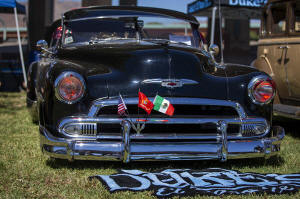Lowriding is more than just cars. It's about family and culture for
Mexican Americans
 Send a link to a friend
Send a link to a friend
 [October 16, 2024]
By FERNANDA FIGUEROA and MELISSA PEREZ WINDER [October 16, 2024]
By FERNANDA FIGUEROA and MELISSA PEREZ WINDER
CHICAGO (AP) — For Luis Martinez, competing in lowriding bike and car
competitions is about more than glory and bragging rights. The lowrider
clubs in the Chicago area have become like one big family and a source
of mutual support.
“It just starts with the metal,” said Martinez, who got his introduction
to lowrider culture when his mother took him to a flea market. He had
his first bike when he was 12.
“To me, it’s about expressing my art and what I can do with my own
hands,” Martinez told The Associated Press as he polished a shiny red
bike at his home in Mishawaka, Indiana.
A movement of expression with origins in Mexican American and Chicano
communities, lowriding is an aspect of Latino history in the U.S. in
which people show their pride, honor family and uplift culture. But
misrepresentation of the culture in entertainment and media has often
associated the lowriding’s “low and slow” motto with gang culture.
Still, decades since its emergence, and as the Hispanic U.S. population
increases, lowriding has experienced a boom, as evidenced by an increase
in car shows and conventions nationwide.
Lowriding involves the customization of a vehicle — from the tires to
the sound system — with vivid designs and colors. Unlike hot rods or
muscle cars, which are often modified to have big tires and move at high
speeds, the lowrider community modified the cars and bikes to go “low
and slow,” said Alberto Pulido, the chair of the Ethnic Studies
department at the University of San Diego.

“It was a way to speak to an identity, a presence and it was done with
few resources,” said Pulido, who also directed the award-winning
documentary, “Lowriding: Everything Comes From the Streets.”
“Our community didn’t have a lot of money,” he said. “They might have
had a little bit expendable income to buy a car but then they were kind
of on their own to create their vehicles. We call that Chicano
ingenuity.”
Lowriding blends Latino and American culture
According to Pulido, lowriding originated in the Southwest, although
there are disputes about where exactly it first appeared. Pulido said
lowriders in Los Angeles would like to make the claim they were the
first, while those in San Diego want their undeniable influence in the
culture acknowledged.
The culture can be traced to post-World War II, when veterans were
coming home with an expendable income. And with the growth of highways
and freeways in California, people wanted to modify their vehicles,
Pulido said.
Today, conventions attract enthusiasts from all over the U.S. Last
month, what was once a small showcase with only 40 lowriders at Lincoln
Park in El Paso, Texas, grew to over 300 lowriders from clubs across the
U.S.
Hector Gonzalez, of the Lincoln Park Conservation Committee, said the
car clubs help members travel to all the showcases in the nation. In the
’70s and ’80s, lowrider clubs became a representation of the community
and offered mutual aid such as ride-sharing and food donations when the
local government could not or would not, Gonzalez said.
“It is something that gets passed on from generation to generation,”
said Gonzalez, who, like most lowriders, was introduced to the community
with a bike at the young age of 13. He has passed on his love for
lowriding to his own children, nephews and cousins
“Kids grow up seeing the cars, they pick it up and they carry on the
tradition,” Gonzalez said.

Lauren Pacheco, co-founder and co-curator of the Slow and Low Chicago
Low Rider Festival, described lowriding as a global, multibillion-dollar
phenomenon of self-expression and innovation.
“It’s a marvel of mechanical innovation,” Pacheco said. “It is the
beautiful artistry in the creative practice of muralism, storytelling
and upholstery.”
Within the last decade, lowrider conventions have grown so much that
they’ve made their way to Japan. In Nagoya, Japanese lowriders have
modified their cars, created clubs and even come to events at Chicano
Park in San Diego.
[to top of second column]
|

A Chevrolet vintage car is pictured during a lowrider exhibition for
the 20th anniversary of Lincoln Park in El Paso, Texas, Sunday,
Sept. 22, 2024. (AP Photo/Andrés Leighton)

Lowrider community sheds gang culture stereotype
Appreciation for lowriding has increased in recent years, enthusiasts
say. But that was not always the case.
In the beginning, lowriding was associated with harmful stereotypes
about Latinos as gangsters, Pulido said. Because the culture involved
predominantly Latino participants, lowriding became racialized and that
overshadowed the artistic and community service aspects of the movement.
The 1979 thriller-drama “Boulevard Nights” also helped to perpetuate the
lowriders as gangsters trope. The film’s main character, Raymond Avila,
played by Richard Yñiguez tried to avoid getting lured into the violent
street gangs of East Los Angeles. Lowriding vehicles and the lowrider
“cholo” aesthetic was featured throughout the film.
While the perception of lowriding has since gotten better, Pulido said
he has been to lowriding car shows where police immediately show up.
Martinez, the Indiana lowrider, said lowriding misconceptions grew in
the Chicago area because the community members were tattooed in ways
often associated with gang affiliation. Pacheco said the Chicago
festival works to dispel those misconceptions.
“We really try not to create a space that glamorizes or romanticizes
gang culture,” she said. “It’s really a celebration of creativity and
innovation and family.”
Lowriding culture becomes a booming industry
Gonzalez, the Texas lowriding showcase organizer, said the culture’s
focus on wheels, hydraulic systems and accessories, has helped lowriding
become a booming industry.
In El Paso, people have opened small businesses orientated to the
lowriding community. In the last couple of years, at least 25 new
businesses opened, including body shops, upholstery shops and apparel
shops, Gonzalez said.
“It has become a mainstream business,” he said. “Back in the 70s and
80s, it was more of a local thing. Everybody helping each other do
things on their own. Now there’s just all kinds of opportunities to
purchase things and have things done to your vehicle.”
Originally from Dallas, Texas, Martinez said he would buy the parts he
needed from a man in his neighborhood, who would buy in bulk from
Lowrider magazine. He said the unfortunate thing about lowriding
becoming so big is parts are now mass produced from China instead of
being Mexican made.

Lowriding carries family legacy
But lowriding is not just about the often pricey task of modifying cars,
Pulido said. It is about building a community that is always there for
each other, throughout generations, he said.
“We have grandparents that are lowriders and then their kids and their
grandkids are in tune already,” Pulido said.
It's a legacy that Sonia Gomez wants for her 8-year-old son, Daniel
Marquez. His late father, Alberto Marquez, had been a member of a
Chicago area lowrider club. Too young to drive the car left to him by
his father, Daniel has a lowriding bike that is more of a memorial to
his dad.
“The bike is what he’s doing to build it up,” Gomez said.
The family will do an ofrenda, a display often associated with Mexican
Dia de los Muertos celebrations, when local lowriding festivals are
held. As part of the ofrenda, Daniel takes an image he has with his
father on a lowriding bike and places it next to his actual bike, which
he named “Wishing on a Star.”
“We would either go on a (lowriding) cruise with my uncle, or we would
go to actual car shows,” Daniel recently recalled, while sitting at the
driver's seat of his dad's lowriding car parked in the driveway of their
home in Frankfort, Illinois.
“My mom would be there,” he said pointing to the passenger seat. “And
I'd be back there all squished.”
All contents © copyright 2024 Associated Press. All rights reserved
 |